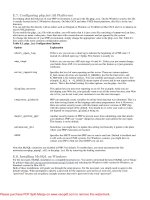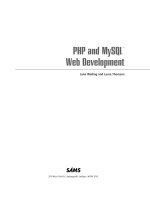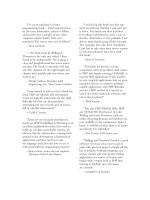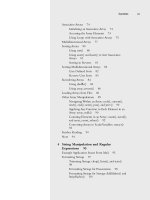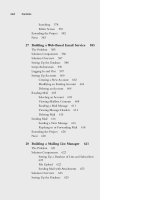PHP and MySQL Web Development - P17 pdf
Bạn đang xem bản rút gọn của tài liệu. Xem và tải ngay bản đầy đủ của tài liệu tại đây (79.79 KB, 5 trang )
47
Iteration: Repeating Actions
At the beginning of each iteration, the condition is tested. If the condition is false, the
block will not be executed and the loop will end.The next statement after the loop will
then be executed.
We can use a while loop to do something more useful, such as display the repetitive
freight table in Figure 1.7.
Listing 1.3 uses a while loop to generate the freight table.
Listing 1.3 freight.php—Generating Bob’s Freight Table with PHP
<body>
<table border="0" cellpadding="3">
<tr>
<td bgcolor="#CCCCCC" align="center">Distance</td>
<td bgcolor="#CCCCCC" align="center">Cost</td>
</tr>
<?
$distance = 50;
while ($distance <= 250 )
{
echo "<tr>\n <td align"="right">$distance</td>\n";
echo " <td align="right">". $distance / 10 ."</td>\n</tr>\n";
$distance += 50;
}
?>
</table>
</body>
</html>
In order to make the HTML generated by our script readable, it needs to include new
lines and spaces. As already mentioned, browsers will ignore this but it is important for
human readers.You often need to look at the HTML if your output is not what you
were seeking.
In Listing 1.3, you will see \n inside some of the strings.When inside a double-quot-
ed string, this character sequence represents a new line character.
for and foreach Loops
The way that we used the while loops previously is very common.We set a counter to
begin with. Before each iteration, we tested the counter in a condition. At the end of
each iteration, we modified the counter.
We can write this style of loop in a more compact form using a for loop.
The basic structure of a for loop is
for( expression1; condition; expression2)
expression3;
03 525x ch01 1/24/03 3:40 PM Page 47
48
Chapter 1 PHP Crash Course
n
expression1 is executed once at the start. Here you will usually set the initial value
of a counter.
n
The condition expression is tested before each iteration. If the expression returns
false, iteration stops. Here you will usually test the counter against a limit.
n
expression2 is executed at the end of each iteration. Here you will usually adjust the
value of the counter.
n
expression3 is executed once per iteration.This expression is usually a block of code
and will contain the bulk of the loop code.
We can rewrite the while loop example in Listing 1.3 as a for loop.The PHP code will
become
<?
for($distance = 50; $distance <= 250; $distance += 50)
{
echo "<tr>\n <td align='right'>$distance</td>\n";
echo " <td align='right'>". $distance / 10 ."</td>\n</tr>\n";
}
?>
Both the while version and the for version are functionally identical.The for loop is
somewhat more compact, saving two lines.
Both these loop types are equivalent—neither is better or worse than the other. In a
given situation, you can use whichever you find more intuitive.
As a side note, you can combine variable variables with a
for loop to iterate through
a series of repetitive form fields. If, for example, you have form fields with names such as
name1, name2, name3, and so on, you can process them like this:
for ($i=1; $i <= $numnames; $i++)
{
$temp= "name$i";
echo $$temp.'<br />'; // or whatever processing you want to do
}
By dynamically creating the names of the variables, we can access each of the fields in
turn.
As well as the for loop there is a foreach loop, designed specifically for use with
arrays.We will discuss how to use it in Chapter 3.
do while Loops
The final loop type we will mention behaves slightly differently.The general structure of
a do while statement is
03 525x ch01 1/24/03 3:40 PM Page 48
49
Next: Saving the Customer’s Order
do
expression;
while( condition );
A do while loop differs from a while loop because the condition is tested at the end.
This means that in a do while loop, the statement or block within the loop is always
executed at least once.
Even if we take this example in which the condition will be false at the start and
can never become true,the loop will be executed once before checking the condition
and ending.
$num = 100;
do
{
echo $num.'<br />';
}
while ($num < 1 );
Breaking Out of a Control Structure or Script
If you want to stop executing a piece of code, there are three approaches, depending on
the effect you are trying to achieve.
If you want to stop executing a loop, you can use the break statement as previously
discussed in the section on switch. If you use the break statement in a loop, execution
of the script will continue at the next line of the script after the loop.
If you want to jump to the next loop iteration, you can instead use the continue
statement.
If you want to finish executing the entire PHP script, you can use exit.This is typi-
cally useful when performing error checking. For example, we could modify our earlier
example as follows:
if( $totalqty == 0)
{
echo 'You did not order anything on the previous page!<br />';
exit;
}
The call to exit stops PHP from executing the remainder of the script.
Next: Saving the Customer’s Order
Now you know how to receive and manipulate the customer’s order. In the next chap-
ter, we’ll look at how to store the order so that it can be retrieved and fulfilled later.
03 525x ch01 1/24/03 3:40 PM Page 49
03 525x ch01 1/24/03 3:40 PM Page 50
2
Storing and Retrieving Data
NOW THAT WE KNOW HOW TO
access and manipulate data entered in an HTML form,
we can look at ways of storing that information for later use. In most cases, including the
example we looked at in the previous chapter, you’ll want to store this data and load it
later. In our case, we need to write customer orders to storage so that they can be filled
later.
In this chapter we’ll look at how you can write the customer’s order from the previ-
ous example to a file and read it back.We’ll also talk about why this isn’t always a good
solution.When we have large numbers of orders, we should use a database management
system such as MySQL.
Key topics you will learn about in this chapter include
n
Saving data for later
n
Opening a file
n
Creating and writing to a file
n
Closing a file
n
Reading from a file
n
File locking
n
Deleting files
n
Other useful file functions
n
Doing it a better way: database management systems
n
Further reading
Saving Data for Later
There are basically two ways you can store data: in flat files or in a database.
A flat file can have many formats but, in general, when we refer to a flat file,we mean a
simple text file. In this example, we’ll write customer orders to a text file, one order per
line.
04 525x ch02 1/24/03 3:38 PM Page 51

